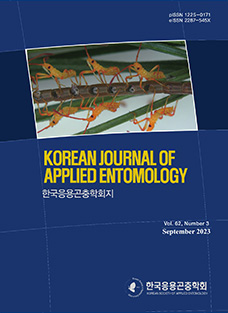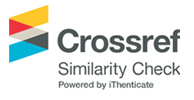The subfamily Apioninae comprises a monophyletic group (Alonso-Zarazaga and Wanat, 2014;Marvaldi et al., 2002). Adults of this subfamily are distinguished by the following morphological characteristics: very small beetles (> 95% 0.75- 3.00 mm in length); a markedly convex to globose, pear-shaped body; straight antennae with a compact club; nine-striate elytra (tribe Apionini) with some genera having remainders of a tenth; two large, usually convex, first ventrites, the second almost vertical at apex; the last three ventrites small, forming a valve-like structure that opens to extrude genitalia; tegmen with fully developed and diverse parameral plate (De Sousa et al., 2019;Alonso-Zarazaga and Wanat, 2014).
Adults feed on living plant tissues, including all green parts as well as fruit. Larvae are usually endophagous and also feed on different plant parts, including stems, roots, inflorescences, fruit, seeds and tissues forming gall-like structures (Alonso- Zarazaga and Wanat, 2014).
The subfamily Apioninae is cosmopolitan and evenly distributed over the continents, with species increasing from cool temperate to warmer zones in both hemispheres (Alonso- Zarazaga and Wanat, 2014). About 205 genera and subgenera and more than 2,200 species and subspecies are included in the subfamily. The estimated minimum species numbers are 500 spp. in Palaearctic region (Alonso-Zarazaga and Wanat, 2014). Only 17 species belonging to seven tribes recorded in the Korean fauna until now (Han et al., 2013;Heo and Hong, 2023). We found three species Eutrichapion (Eutrichapion) ervi (Kirby, 1808), Pseudaspidapion botanicum (Alonso-Zarazaga and Wang, 2011) and Sergiola (Golovninia) hilleri (Schilsky, 1902) for the first time in Korea. In this paper, we report new records including their morphological characteristics, photographs of adults, and host information.
Materials and Methods
Examined specimens were based on samples collections from 2021 to 2022 in Sunchon National University (SCNU). Specimens were taken pictures with a digital USB 3.0 microscope camera (DMC5400) that is attached to Leica M125 Stereo microscope. The pictures were stacked by using the LAS software (version X). Specimens examined in this study are deposited in insect collections of the Department of Agricultural Life Science in SCNU.
Taxonomic accounts
Subfamily Apioninae Schonherr, 1823
Tribe Apionini Schonherr, 1823
Subtribe AspidapiinaAlonso-Zarazaga, 1990
Genus PseudaspidapionWanat, 1990
PseudaspidapionWanat, 1990: 58. [Type species: Apion spadiceum Wagner, 1908]
Diagnosis: This genus is quite similar to genus Aspidapion, but it can be distinguished from the latter by relatively equal width of elytral striae and interstriae, and the absence of protibial mucrones in males, among other features (Wanat, 1990).
Number of species: 17 paleotropical species, eight palaearctic species and four Chinese species (Alonso-Zarazaga et al., 2011;Alonso-Zarazaga, 2023).
Distribution: Korea (new record), China, India, East Africa (Alonso-Zarazaga et al., 2011).
Pseudaspidapion botanicumAlonso-Zarazaga and Wang, 2011
장구밥창주둥이바구미(신칭) (Fig. 1)
Pseudaspidapion botanicum Alonso-Zarazaga and Wang in Alonso-Zarazaga et al., 2011:: 43. [Type locality: China - Beijing]
Diagnosis. Body (Fig. 1) generally piceous black. Scales on pronotal disc thicker, denser and longer, tips of posterior scales surpassing the anterior by almost the basal half. Antennal scape apex and pedicel with sparse short greyish hairs; pedicels at least 2 × as long as wide. Rostrum cylindrical and moderately robust, 1.45× as long as pronotum in midline. Metarostrum microreticulate, matt, pro- and mesorostrum smooth, shining, sparsely punctulate. Pronotum campaniform, transverse, weaker subapical constriction, sides weakly dilated at middle, bisinuate with moderate medial rounded projection towards scutellum. Prescutellar fovea shallow, indistinct, sublinear, prolonged apical to middle. Scutellum with two basal tubercles separated by a weak median depression, subacutely prominent in lateral view, in front view tubercles fused basally. Meso- and metatibiae mucronate in males.
Body length (excluding rostrum) 1.8-2.0 mm.
Specimen examined. [SCNU] Bogildo, Wando-gun, Jeollanam- do, 1♂, 2♀, 07.vi.2022, collected on the leaf of Sageretia thea (Osbeck) M.C. Johnst. (Rhamnaceae), Y. Heo.
Distribution. Korea (new record - South), China (Beijing, Shaanxi) (Alonso-Zarazaga, 2023).
Biological notes. Alonso-Zarazaga et al. (2011) reported that this species was collected from Grewia biloba G. Don var. parviflora (Bunge) Hand.-Mazz. (Malvaceae) in Beijing and Shaanxi province, China. The adults feed on leaves and flower buds of their host, while they mate and oviposit in the bud. The egg is located in the androecium, and then the larva feeds on the pistil and pupates there. On the other hand, we have collected this species on the leaves of Sageretia thea (Osbeck) M.C. Johnst. (Rhamnaceae) in Korea.
Tribe Apionini Schonherr, 1823
Subtribe IxapiinaAlonso-Zarazaga, 1990
Genus SergiolaKorotyaev, 1996
Sergiola Korotyaev in Korotyaev & Egorov, 1996: 862. [Type species: Apion silfverbergiBajtenov, 1983]
Diagnosis. Rostrum thicker, not usually narrower than profemora. Base of antennae in female closer to eyes. Thickened white scales around eyes and on sides of prothorax in male less distinct. Elytra narrower, Legs short, protibiae wider, almost always straight. (Korotyaev and Egorov, 1996).
Number of species: Seven palaeartic species under two subgenera (Alonso-Zarazaga, 2023).
Distribution: Korea, China, Japan, Siberia (Alonso-Zarazaga and Lyal, 1999).
Key to the subgenera (or species) of the genus Sergiola in Korea
-
1. Elytra wide, strongly convex; rostrum thin, in male 1.5 - 1.75 times as long as pronotum, slightly narrower than profemora. In female, antennal insertions 1.4 - 1.7 times rostral width distant from eyes. Legs long and thin; protibiae slightly bent inward at apex [Subgenus Golovninia Korotyaev and Egorov] ···············································································S. (Golovninia) hilleri (Schilsky)
-
- Elytra narrower, rostrum thicker, usually not narrower than profemora. Antennal insertions in female closer to the eyes. Legs shorter, protibiae wider, almost always straight ··········································Subgenus Sergiola Korotyaev
Subgenus GolovniniaKorotyaev and Egorov, 1996
GolovniniaKorotyaev and Egorov, 1996: 873. [Type species: Apion hilleriSchilsky, 1902]
Sergiola (Golovninia) hilleri (Schilsky, 1902) 빈도리창주둥 이바구미(신칭) (Fig. 2)
Apion hilleriSchilsky, 1902: 67. [Type locality: Japan - Hagi]
Diagnosis. Body (Fig. 2) Body black, dull, moderately densely haired with yellowish gray; Antennae reddish yellow, clubs brownish black. Forehead with three faint streaks and a frontal depression. Rostrum strongly curved, shiny; punctures fine, clearly visible; approximately as long as the length of head and pronotum together, subparallel from eyes to antennal insertions, narrowed beyond insertions, slightly broadened at apex, thicker at the antennal scrobes. Antennae slender, indented in the last third of the rostrum; Elytra strongly arched (similar to A. pracearium), short, elliptical, very slightly rounded in the middle, much broader at the base than the pronotum, deeply punctured and striped; punctures in the striae strong, chain-like, the 1st stria reached at base of elytra. Legs slender, tibiae without hairy bristles at tip; Tarsi short, 1st segment a little longer than 2nd, 2nd segment wider than its length; Claws widened like teeth at the base.
Body length (excluding rostrum) 2.3 mm.
Specimen examined. [SCNU] ♀, Bukdaesa, Mt. Odae-san, Pyeongchang-gun, Gangwon-do, 18.vi.2010, S. Park.
Distribution. Korea (new record - Central), Japan (Honshu, Shikoku, Kyushu) (Morimoto, 1994;Alonso-Zarazaga, 2023).
Biological notes. Morimoto (1994) reported that this species was collected on Deutzia crenata Siebold and Zucc. (Hydrangeaceae) in Japan.
Subtribe OxystomatinaAlonso-Zarazaga, 1990
Genus EutrichapionReitter, 1916
EutrichapionReitter, 1916: 243. [Type species: Attelabus viciae Paykull, 1800]
Diagnosis. Basal flange of pronotum present. Antennal scrobes in lateral view sulciform, narrow, not prolonged and well limited apicad Female prorostrum in dorsal view evidently narrowed at base, tubiform, impunctate to apex; mesorostrum wider than apex. One specialized seta on apical third of 7th interstria, another near apex of 9th. First sternite 1.6-1.7 X as long as 2nd. Male pygidium with apical flange slightly sinuate at middle (Alonso-Zarazaga, 1990).
Number of species: 16 palaearctic species under four subgenera (Alonso-Zarazaga, 2023).
Distribution: Holarctic (Alonso-Zarazaga and Lyal, 1999).
Subgenus EutrichapionReitter, 1916
EutrichapionReitter, 1916: 243. [Type species: Attelabus viciae Paykull, 1800]
PseudotrichapionBokor, 1923: 101. [Type species: Attelabus viciae Paykull, 1800]
Key to the species of the subgenera Eutrichapion in Korea
-
1. Legs black, tarsi sometimes dark brown ············································································E. (s. str.) ervi (Kirby)
-
- Legs yellowish red, coxae and trochanters black, tarsi and hind tibiae darker ···········································································································E. (s. str.) viciae (Paykull)
Eutrichapion (Eutrichapion) ervi (Kirby, 1808) 검은다리창 주둥이바구미(신칭) (Fig. 3)
Apion erviKirby, 1808: 23. [Type locality: England, Sweden]
Apion lathyriKirby, 1808: 24. [Type locality: England]
Apion opthalmicumDesbrochers des Loges, 1896: 71.
Apion nigroclavatumGerhardt, 1911: 338.
Apion kihigeNakane, 1963: 358.
Apion amurenseBajtenov, 1983: 19.
Diagnosis. Body (Fig. 3) black. Antennal scape and first two funicular segments yellowish brown, following funicular segments gradually reddish brown, club dark brown. All legs black, tarsi sometimes dark brown. Dorsum covered with faint lying hairs. Male head faintly transverse with bulging eyes, thinly striped forehead, rostrum slightly longer than pronotum. Antennae inserted behind the middle of rostrum; scapes straight to slightly curved, subclavate; clubs ovate to elongate, 1.75-2.50 X as long as wide, sutures visible. Elytra oval, with shoulder bumps, sides slightly rounded, widest behind the middle. Striae distinct; intervals flat, wider than the striae. Legs slender, tibia thin, straight, slightly widened towards the tip. Claws with small teeth at the base. Aedeagus in the distal third with a narrowed tip. Sexual dimorphism: female rostrum thicker, about 1.5 times longer than pronotum, antennae inserted in the posterior third of rostrum.
Body length (excluding rostrum) 2.2 mm.
Specimen examined. [SCNU] 1♂, 1♀, Mt. Jeombong-san, Jindong-ri, Girin-myeon, Inje-gun, Gangwon-do, 24.v.2011, S. Park; ♀, Sanmyeong reservoir, Sammyeong-ri, Cheolwoneub, Cheolwon-gun, Gangwon-do, 27.viii.2010. S. Park.
Distribution. Korea (new record - Central), Japan (Hokkaido, Honshu), Mongolia, Russia (Far East, East Siberia, West Siberia, European part), Syria, Turkey, Algeria, Europe (Alonso-Zarazaga, 2023).
Biological notes. This species was reported by Morimoto (1994) to have been collected on Vicia cracca L. (Fabaceae) in Japan and by Kirby (1808) on Lathyrus pratensis L. (Fabaceae) in Europe.












 KSAE
KSAE





